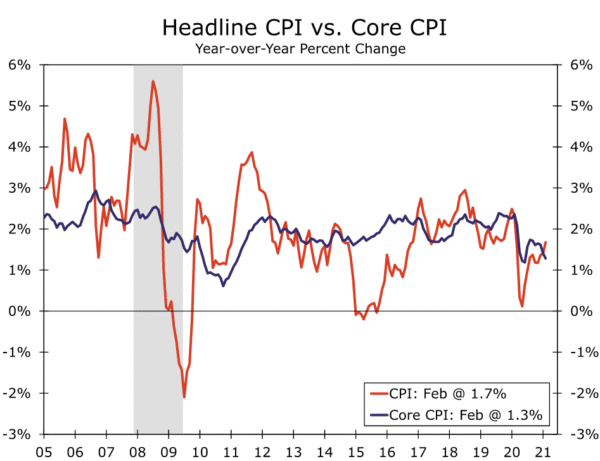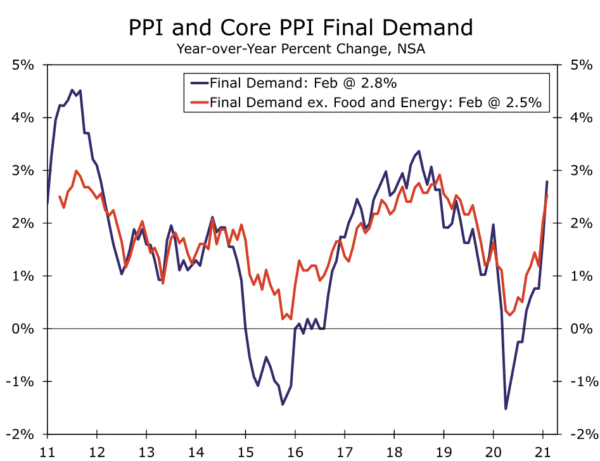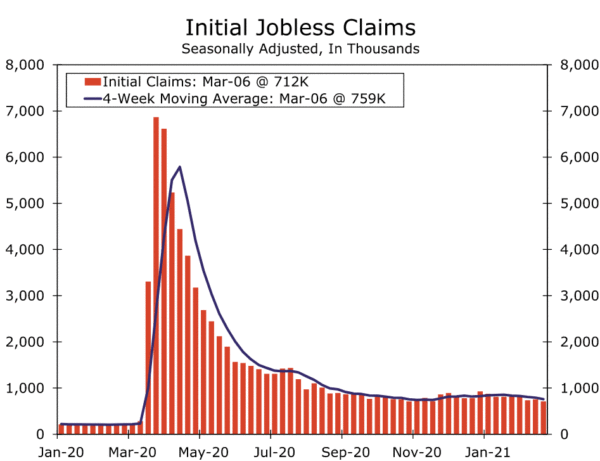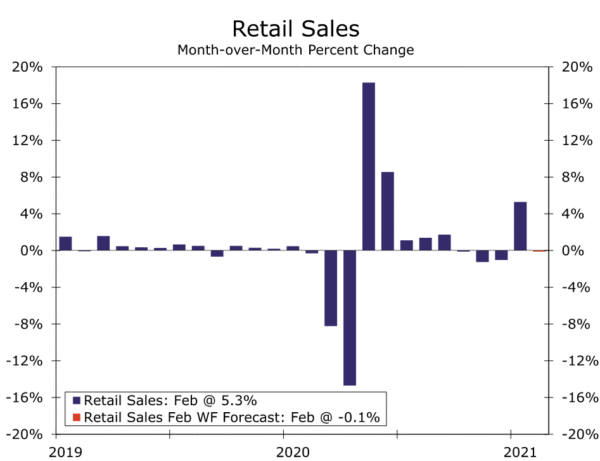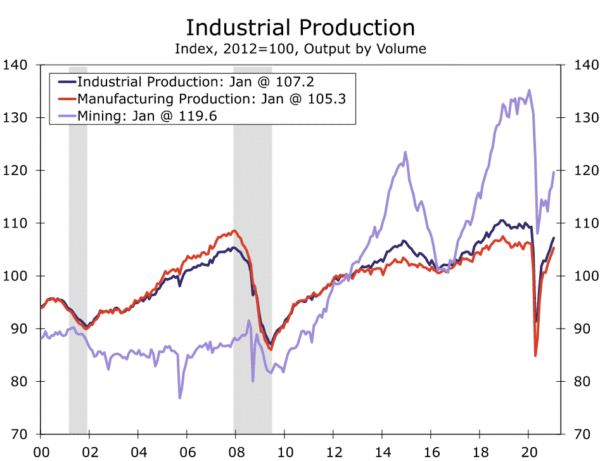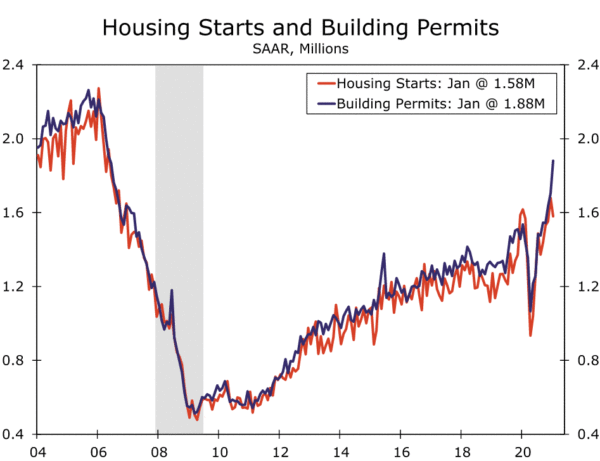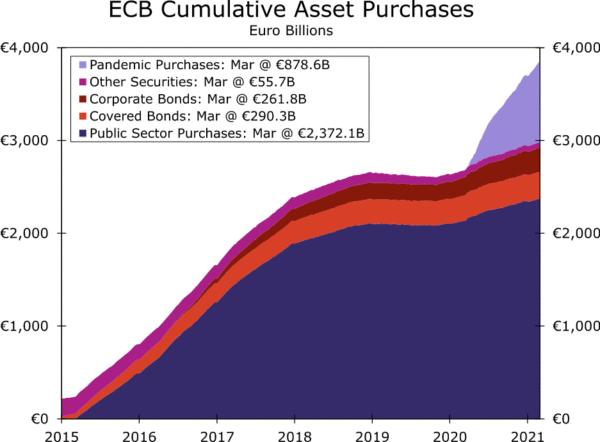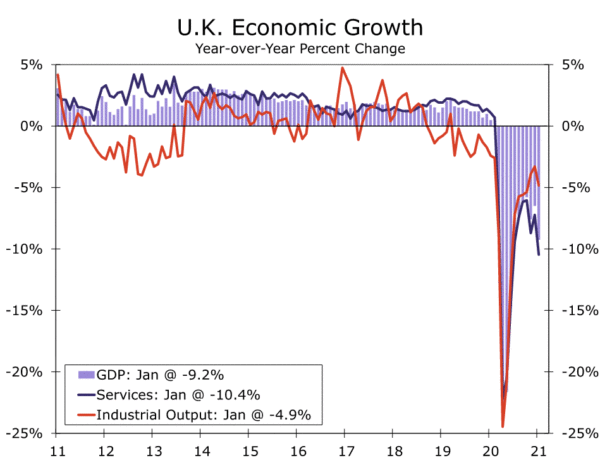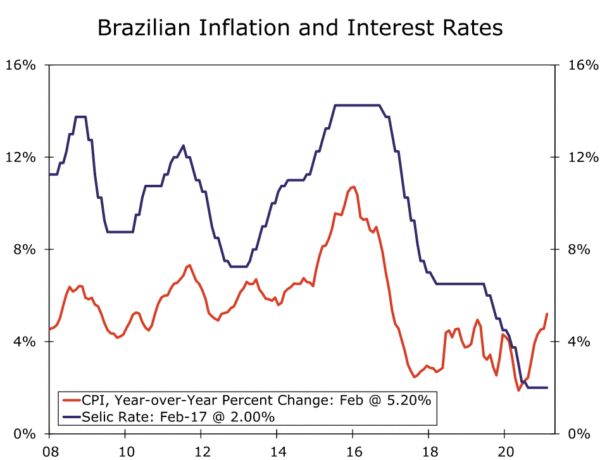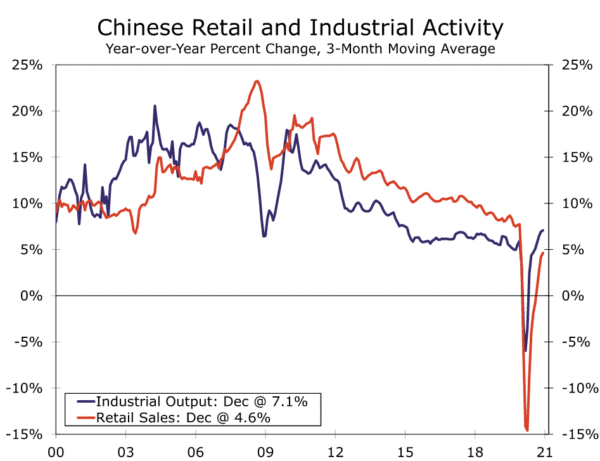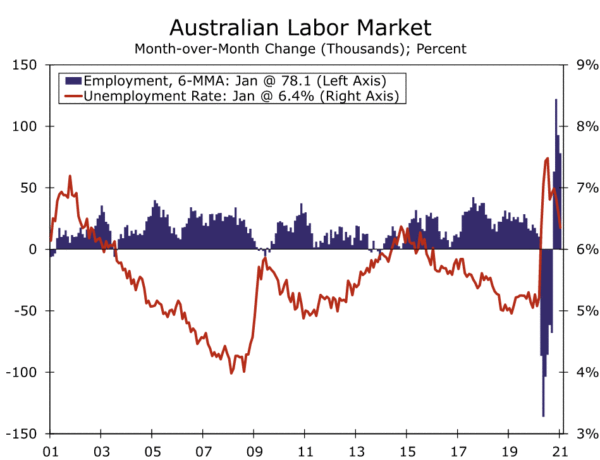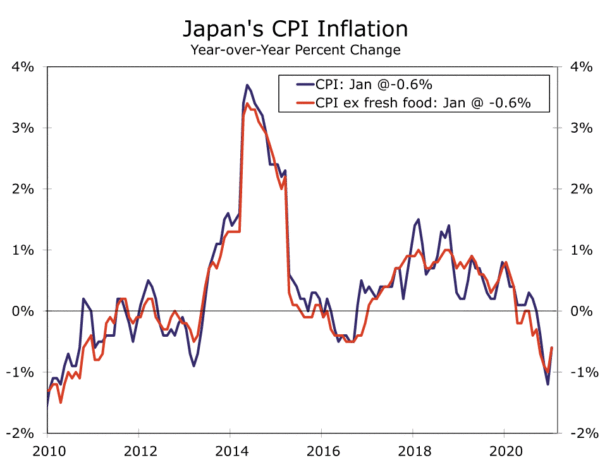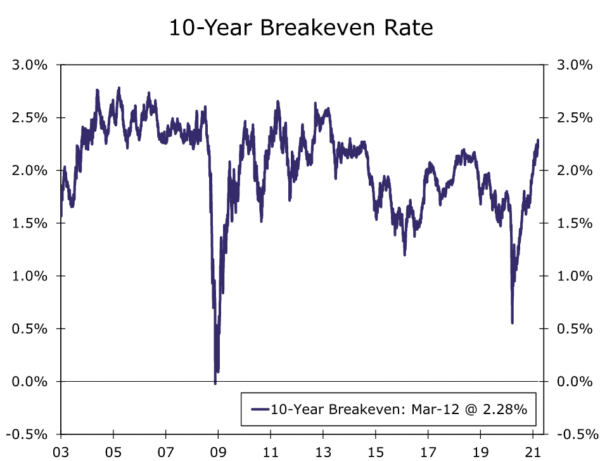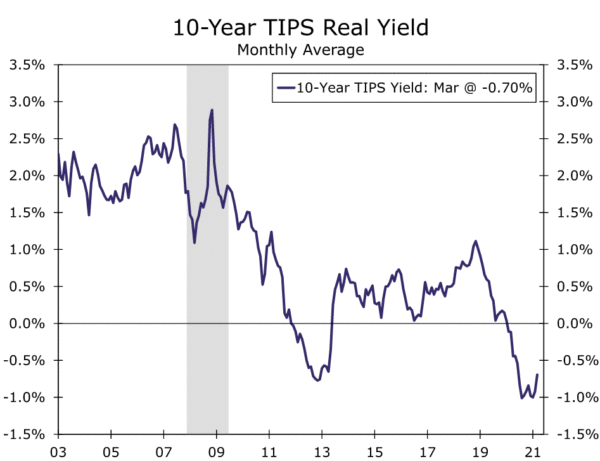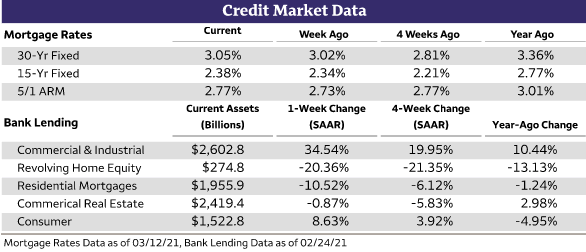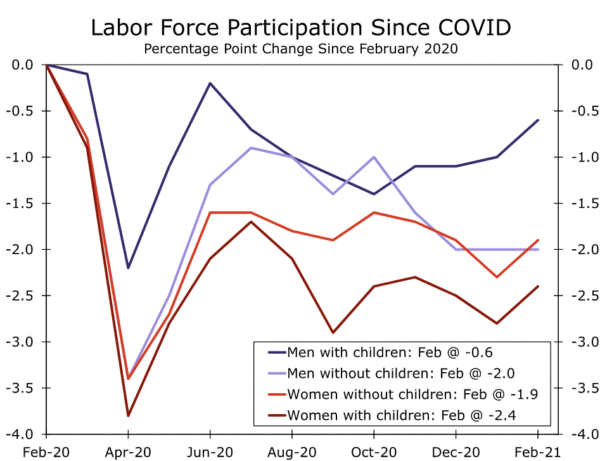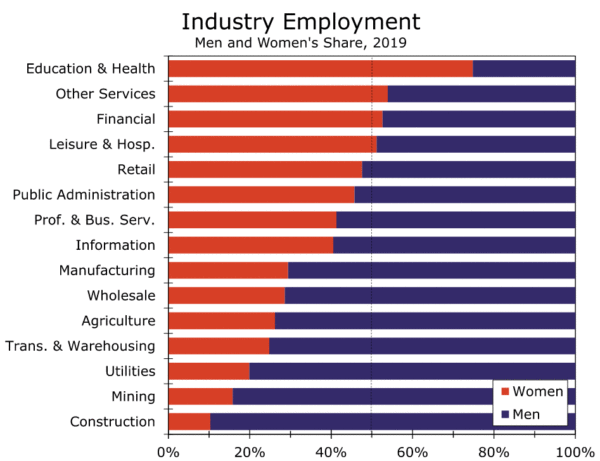U.S. Review
Inflation Begins Spring Bloom
- Inflation appears to be heating up. During February, the Consumer Price Index (CPI) rose 0.4% and the Producer Price Index (PPI) advanced 0.5%. The NFIB Small Business Optimism Index edged up to 95.8 in February, reflecting growing optimism on vaccinations and lighter COVID-related business restrictions.
- Jobless claims dipped to 712K during the week ending March 6. Jobs openings (JOLTS) during January jumped to 6.9 million, the most since pre-pandemic. Consumer sentiment (University of Michigan, preliminary) spiked to 83 amid falling COVID cases and news of more fiscal stimulus on the way.
Global Review
European Economic Trends Remain Unsettled For Now
- The Eurozone economy entered 2021 on an unsettled note. Comprehensive Q4 GDP figures showed a 0.7% quarter-over-quarter decline and, within the details, and large fall in consumer spending and overall final domestic demand. With economic trends uncertain, the European Central Bank leaned against rising yields, saying it would significantly increase the pace of its bond purchases in the months ahead. The effect of renewed restrictions in the U.K. was evident in January GDP figures, which showed a fall of 2.9% month-over-month.
- Next week’s data, from outside of Europe, might be more upbeat. Among the releases, China is expected to report sizable gains in retail sales and industrial output for early 2021, while Australia is expected to report another rise in employment for February.
U.S. Review
Inflation Begins Spring Bloom
The weather is not the only thing beginning to warm up. The Consumer Price Index (CPI) rose 0.4% during February, the strongest monthly increase since last August. The headline index is now up 1.7% over the past year. While inflation still remains generally subdued, price pressures are starting to firm. Much of February’s increase was owed to a 3.9% rise in energy prices, however food prices also edged up during the month. Core inflation picked-up slightly compared to the flat readings of the past several months, but still rose 0.1% during the month.
Despite remaining fairly benign at present, inflation appears headed for a spring bloom. Over the next few months, the yearly comparisons will likely be overstated by easy base comparisons (prices dipped during the lockdown period last spring), but more fundamental factors are likely to add to price pressures. For one, services inflation is poised to be reawakened alongside unleashed consumer demand for the high-contact services which have been limited by COVID safety protocols for much of the past year.
Furthermore, commodity prices are climbing and factory-gate inflation is starting to build. The Producer Price Index (PPI), which tracks average selling prices received by producers, rose 0.5% during February. The PPI is now up 2.8% over the year. The PPI excludes sales taxes, retail mark-ups and transporting costs, so it is not a reliable predictor of consumer price changes. What’s more, businesses appear to be positioning themselves to pass on higher costs. The NFIB Small Business Optimism survey showed a net 34% of businesses planning to raise prices in the next three months, the largest share in more than 12 years.
Despite the recent margin-crimping rise in operating costs, overall small business optimism appears to be creeping higher. During February, the NFIB’s Small Business Optimism Index climbed 0.8 points to 95.8. The harsh winter weather experienced by much of the central U.S. probably weighed on sentiment, but businesses are becoming more optimistic. The proportion of small business owners expecting the economy to improve rose four points in February, although the measure remains exceptionally low at -19%. Moreover, five of the survey’s 10 indicators rose, led by a seven point gain in job openings.
It’s not just small businesses that appear to be ramping up hiring. Job openings (according to the Job Opening and Labor Turnover Survey, or JOLTS) jumped to 6.9 million in January. The unexpected surge brings the total number of job openings back to a level which is roughly consistent to pre-pandemic levels. Jobless claims during the first week of March also dipped, which is yet another sign that the labor market recovery is starting to get back on track. First time claims for unemployment benefits fell to 712K, while the number of people on regular continuing claims dipped to 4.14 million in the last week of February. Jobless claims remain highly elevated by historical standards, but the gradual improvement seen over the past few weeks is an encouraging sign that hiring is beginning to pick up ahead of the surge in pent-up demand which we expect to occur alongside widespread vaccinations.
We expect the $1.9 trillion COVID financial relief bill signed into law this week will provide an additional boost to spending. The main feature of the package is to send direct checks to many households, which should bolster consumer confidence. The University of Michigan’s preliminary gauge of consumer sentiment for March spiked to 83 from 76.8. The continued decline in COVID cases and news of another round of fiscal stimulus both played a role in improving confidence. Because the stimulus checks won’t start hitting bank accounts until next week, the final reading of sentiment released towards the end of the month could conceivably produce an even higher reading. Another round of fiscal support has also led us to ramp up our expectations for real GDP growth this year. We now look for full-year GDP growth for 2021 to come in at an above-consensus 6.4%. If realized, that rate would mark the fastest pace of growth for the U.S. economy since 1984.
U.S. Outlook
Retail Sales • Tuesday
We expect some modest payback in the February retail sales data after a surge in spending the prior month. Direct checks from the December fiscal relief package burned a hole in consumers’ pockets in January and resulted in the largest spending gain since June for most retailers. When we get the retail spending data for February next week, we expect some payback is in order. Autos likely will play a large part in the decline in sales from January based on the pullback in vehicle sales data for the month. In fact, excluding autos we expect sales rose 0.2%. Some weakness may also show up in the restaurant component, based on the high-frequency data from OpenTable on seated diners. But, other measures suggest activity and consumption more broadly continued to improve in February.
If consumption comes in better-than-expected in February, the rapid improvement in the virus situation and optimism of an improving economic backdrop amid further stimulus is already boosting consumption. A worse print could suggest even more payback from the January spending surge than we forecast. The bottom line is, with another round of fiscal stimulus passed this week and many households set to get another round of direct checks that are more than double what they received in January, we expect spending to receive another jolt in just a few months time. After that, the record amount of “excess” savings should provide ample support to fund consumption as the public health situation improves and restrictions on activities are eased. We forecast above trend consumption through 2022.
Previous: 5.3% (Month-over-Month); Wells Fargo: -0.1%; Consensus: -0.3%
Industrial Production • Tuesday
We expect that the industrial sector hit pause on its impressive recovery in February. The manufacturing sector continues to report an improvement in activity, supported by lean inventories and an increasing backlog of orders. But, manufacturing output likely hit a snag in February amid input shortages, particularly of semiconductor chips, which likely weighed on auto and computer output last month. Supply bottlenecks and shortages extend beyond chips, however, and appear to be ravaging the sector. Longer supplier delivery times are being reported and anecdotal comments from manufacturers in the latest ISM reports continue to emphasize difficulties across the supply chain. Brutal winter weather across the country in February likely also weighed on production during the month.
We expect industrial production slipped 0.2% in February. If output was worse than expected, supply bottlenecks and labor shortages likely weighed on activity more than we anticipated. A better-than-expected outturn for output, however, suggests the industrial sector continued to produce despite these headwinds. After a pause in output in February, activity should pick up again as lean inventories and order backlogs keep the industrial sector humming this year.
Previous: 0.9% (Month-over-Month); Wells Fargo: -0.2%; Consensus: 0.4%
Housing Starts • Wednesday
Home building remains one of the strongest parts of the economy, but we may see some near-term weakness in the February data released next week. The harsh winter weather across the country during February likely weighed on starts across the country. Even with some near-term weakness, however, home building still has plenty of momentum. Home builders remain upbeat with the NAHB/Wells Fargo housing market index rising to 84 in February, which remains in line with its average for the past six months. Exceptionally lean single-family housing inventory and our expectation for strong demand should continue to boost housing starts this year. Specifically, we expect home building to get a boost from the easing of restrictions across the country this spring. That said, the sector is not without its challenges. Home builders continue to face rising input costs, particularly for lumber prices, and labor shortages, which remain some of the largest headwinds to the sector.
Previous: 1,580K (SAAR); Wells Fargo: 1,587K; Consensus: 1,570K
International Review
European Central Bank Holds Steady, Eurozone Indicators Still Mixed
The European Central Bank (ECB) kept its monetary policy stance unchanged at its policy meeting this week, maintaining its Deposit rate at -0.50% and making no change to the size of its asset purchase programs. However, the ECB made an important policy tweak, saying that it “expects purchases under the Pandemic Emergency Purchase Program (PEPP) over the next quarter to be conducted at a significantly higher pace than during the first months of this year,” imparting an overall dovish tone. The ECB’s tweak comes after several policymakers said they were monitoring bond markets closely and indicated some concern about a premature rise in bond yields. Meanwhile, the ECB’s updated economic projections were little changed from the prior forecast in December. The ECB projected higher CPI inflation of 1.5% for 2021, but its CPI forecasts for 2022 and 2023 were largely unchanged from previously.
This week’s Eurozone data were mixed, highlighting some of the near-term challenges the economy still faces. Detailed Eurozone Q4 GDP figures were released—they showed overall GDP fell 0.7% quarter-over-quarter, with consumer spending slumping by 3.0%. Thus even with fixed investment spending showing a gain of 1.6%, we estimate final domestic demand (consumer, government and investment spending) fell 1.2% quarter-over-quarter, indicating a still subdued underbelly for the Eurozone economy. As for early 2021, January industrial activity was also decidedly mixed. Germany and Spain reported monthly declines in industrial output, while France and Italy reported monthly increases. For the Eurozone region overall, January industrial output rose a moderate 0.8% month-over-month.
United Kingdom: Economic Pain Before the Economic Gain
The extent of the hit to the U.K. economy from the last wave of COVID cases and associated lockdown measures was revealed this week with the release of January GDP figures. The U.K. economy fell 2.9% month-over-month in January, a result that had been flagged by the previously reported sharp decline in January retail sales. Indeed, most of the economic weakness was centered in the service sector which shrank by 3.5%, while the decline in industrial output was 1.5%. The January fall in GDP leaves the economy on course to contract in Q1 overall, with the level of U.K. GDP in January some 3.0% below its Q4 average. The U.K. government also only announced in late February a cautious timetable for re-opening the economy over the next several months.
Nonetheless, the economic pain we are seeing from the U.K. in early 2021 is coming ahead of what should be economic gains later in the year. The U.K. has made good progress so far, by international standards, in vaccinating its population against COVID, while household finances suggest consumers will be in a good position to spend once the economy opens up. These are among the reasons that could dissuade the Bank of England from easing monetary policy further. The central bank meets next week and should keep its policy rate at 0.10% and also keep its asset purchase target unchanged. Looking further beyond next week, at this time our base case is that the Bank of England will not ease monetary policy further from its current policy stance.
Latin America: Upstairs or Downstairs for Policy Interest Rates?
This week’s developments in Brazil support the notion that Brazil’s Central Bank (BCB) could begin raising interest rates shortly, potentially as soon as next week. February’s inflation figures saw a further acceleration, with the CPI rising 5.20% year-over-year. While the pickup of inflation might stem in part from some softening in Brazil’s currency since early 2021, a movement towards more expansive fiscal policy could also be underpinning prices. This week the House passed a first vote reviving last year’s monthly payments to low income individuals, a measure expected to cost 44 billion reais. Those payments could be a welcome boost to the economy—even though GDP grew for Q4 overall, growth momentum has slowed in recent months. For example, Brazil’s January retail sales dipped 0.2% month-over-month, following a large 6.2% fall in December. Given quicker inflation, a weaker currency, and impending fiscal support, the consensus forecast is for Brazil’s central bank to increase its Selic rate 50 bps to 2.50% at next week’s monetary policy announcement.
In contrast, the Central Bank of Mexico voted unanimously to lower its overnight rate at its most recent policy meeting, raising expectations that further rate cuts could be forthcoming. Mexico’s February inflation saw a modest quickening, as the headline CPI firmed to 3.76% year-over-year and core CPI inflation edged higher to 3.87%. While that could give the Central Bank of Mexico at least some reason for pause ahead of further easing, our base case remains for a further 25 bps rate cut at the central bank’s March monetary policy meeting.
International Outlook
China Retail Sales & Industrial Output • Monday
Next week’s retail and industrial activity from China will offer an early read on the state of the economy in early 2021, although separating the signal from the noise to assess the underlying trend of the economy might be challenging. Recall that China’s economy was badly affected by the COVID outbreak in Q1-2020, meaning a sharp jump in activity will result purely from base effects. In addition, the variable timing of the Chinese New Year holiday could also add to the volatility of the data.
External trade figures for January-February were upbeat, with exports for the two-month period up 60.6% year-over-year when compared to January-February 2020. In contrast, confidence surveys have been mildly soft in tone, as February saw a decline manufacturing and services indices for both the official PMI and the Caixin PMI. With the underlying trend perhaps difficult to discern, the market’s focus might simply be on whether the retail sales and industrial output beat the consensus forecast, as the export data did. On that front, we note that the consensus forecast is for retail sales to rise 32.0% year-over-year in January-February, while the forecast is for industrial output to rise by 32.2%.
- Previous: -3.9% (Retail Sales); 2.8% (Industrial Output), Year-to-Date
- Consensus: 32.0%; 32.2%
Australian Employment • Thursday
Australia’s February employment report could continue a run of generally solid economic data. Employment has increased four months in a row, led by gains in full-time jobs, while more broadly Australia’s Q4 GDP was a positive surprise with a gain of 3.1% quarter-over-quarter. For February, the consensus expects an increase in employment of 30,000, while the unemployment rate is expected to fall further to 6.3%. February retail sales are also released next week, with the consensus forecasting an increase of 0.6% over the month.
In other data from Down Under, New Zealand publishes Q4 GDP figures next week. The New Zealand economy rebounded strongly in Q3, as GDP rose 14.0% quarter-over-quarter. The indications for Q4 GDP have been mixed, including a solid employment report and a modest gain in real manufacturing activity, but a drop in real retail sales. As a result, the consensus forecast is that New Zealand Q4 GDP rose only a modest 0.1% quarter-over-quarter, following the large Q3 increase.
- Previous: 29,100; 6.4% (Monthly employment change; Unemployment Rate)
- Consensus: 30,000; 6.3%
Bank of Japan Policy Announcement • Friday
The Bank of Japan (BoJ) announces its monetary policy decision next week and, in terms of its key policy instruments, we do not anticipate any change. We expect the BoJ to keep its policy rate at -0.10%, while we expect the target for the 10-year government bond yield to remain “around zero percent.”
Of greater interest for market participants will be the results of the central bank’s policy strategy review which are also due to be announced. With CPI inflation back in negative territory and well away from the central bank’s goal of 2%, policymakers are conducting a more in-depth review of how monetary policy is conducted. Ahead of those results, BoJ Governor Kuroda opined that there was no need to widen the tolerance range for the 10-year yield target, which is currently +/- 20 bps, although other policymakers called for yields to fluctuate more freely within that range. Among other areas investors could focus on are whether the central bank could indicate there is still scope for policy interest rates to fall further, and the magnitude and mix (short-maturity versus long-maturity) of government bond purchases. Overall we expect the results of the policy strategy review to be more dovish than hawkish, which could weigh on the Japanese currency.
- Previous: -0.10% (Policy Rate); 0.00% (10-Year Government Yield Target)
- Wells Fargo: -0.10%; 0.00%
Interest Rate Watch
Inflation Expectations Doing Most of the Heavy Lifting on Higher Yields
On August 4, 2020 the 10-year Treasury security finished the day with a yield of just 0.51%, an all-time low. Since then, yields on 10-year Treasuries are up about 100 bps. How much of this move in yields is due to higher expected inflation, and how much can be attributed to other factors that push up real yields?
In addition to benchmark Treasury securities that pay a fixed coupon, the U.S. Treasury also issues Treasury Inflation-Protected Securities (TIPS). Unlike coupon-based Treasury security, TIPS adjust for realized inflation, hence their name. The price/yield difference between a 10-year Treasury security with a fixed coupon and a 10-year TIPS serves as a rough proxy for what markets expect inflation to be over the next 10 years. This difference is often referred to as the “breakeven rate” since it measures how much realized inflation would make investors indifferent between the two securities. Since August 4, 10-year breakevens have risen about 70 bps, while real yields have risen about 30 bps. Thus, it seems fair to assert that the 100 bps increase in total yields for the 10-year Treasury has primarily been driven by higher than expected inflation.
As we look to the future, however, we suspect that real yields will have to do more of the heavy lifting if interest rates are to rise as we expect. As the charts illustrate, 10-year breakevens have already surpassed their pre-pandemic levels and are at a seven-year high. Real yields, as implied by 10-year TIPS, have ticked higher in recent weeks, but they remain quite low by historical standards. Perhaps 10-year breakevens can go a bit higher, but we are skeptical they can push nominal Treasury yields all that much higher. Yes, the Federal Reserve’s new average inflation targeting regime suggests the Fed will tolerate inflation a bit above 2% for a period of time, but will the central bank tolerate inflation that averages 2.5%-3.0% for an entire decade? We suspect the answer is probably not. We look for 10-year Treasury yields to rise another 50 bps by year-end 2021, then 25 bps more in 2022 to finish the year at 2.25%.
Topic of the Week
Choose To Challenge
On International Women’s Day we celebrate women’s rights and achievements in social, economic and political spheres. The day often serves as a call to action to accelerate and raise awareness about gender equality. In observance, we reflect on the pandemic’s effect on women’s labor force participation in the United States.
The pandemic has underscored both the importance of women’s contribution to the economy and the disproportionate burdens they carry. Women were not on equal footing before the pandemic, but at least by many measures, things were moving in the right direction. That momentum has reversed over the past year. In contrast to prior recessions, women have experienced particularly steep job losses during the COVID downturn.
Since last February, more than 2.4 million women have left the labor force compared to 1.9 million men. The greater exodus is likely due to, at least in part, women being more responsible for unpaid at-home work and childcare. Even in households where both parents work full-time, mothers spend on average four hours more per week on childcare than their partners. While labor force participation has declined steeply for women overall, the gap between mothers and fathers has widened more than between men and women without children.
It’s not just childcare issues that have driven women out of the labor force in larger numbers this past year. Women account for more than half of employment in industries that provide discretionary services that are least compatible with social distancing, such as leisure & hospitality and personal services. Steep job losses in these fields have left women with fewer job opportunities. Women also account for a large share of employment in frontline industries like healthcare, forcing many to make tough decisions between work and potential exposure to COVID.
The pay penalty that comes with breaks in employment stands to aggravate the existing earnings gap and reduce the incentive to return to work. This is not just a setback for women, but for the entire economy. Potential economic growth can be boiled down to growth in hours worked and labor productivity. Both stand to be negatively affected by the unequal toll the pandemic has taken on women in the workforce.
Looking ahead, women’s labor force participation and entrepreneurship may benefit from the post-COVID work environment. The pandemic has made employers more comfortable with remote work, which could create a flexible work-from-home environment that could pull more women into the labor force. Furthermore, robust fiscal support leaves the U.S. economy, and specifically the hard-hit services sector, in a better position coming out of this crisis than in the aftermath of the financial crisis. Expectations for a quick snap back in service-sector activity may also boost hiring in industries where women represent a larger share of workers.
Making sure that women are able to fully participate in the labor force is vital to sustain the expansion and lift the potential growth rate for the broader economy.




